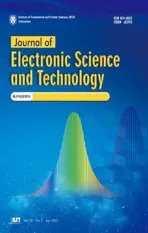Journal of Electronic Science and Technology Information for Authors
2023-01-05
Journal of Electronic Science and Technology (JEST) is published quarterly.All original contributions are welcomed which relate advances or state-of-the-art achievements in electronic science and technology, including communications systems and networks, signal processing, information and image processing, circuits and systems, microelectronics,electronic devices and materials, computer science, microwave technology, physical electronics, optoelectronics,mechatronics,control and automation,electronics with life science,and new applications of electronics.
Submission:Submission of a manuscript amounts to assurance that it has not been copyrighted, published or accepted for publication elsewhere, that it is not currently being considered for publication elsewhere, and that it will not be submitted elsewhere while under consideration.Manuscripts should be specially prepared for publication in this Journal and submitted electronically by e-mail to journal@uestc.edu.cn.To ensure rapid communication, authors should include full post address,telephone and e-mail address.Authors should allow approximately 8 weeks for the initial review cycle.The acceptable manuscripts should be prepared in MS Word using the JESTC template, available at: http://www.journal.uestc.edu.cn or https://www.keaipublishing.com/en/journals/journal-of-electronic-science-and-technology/guide-for-authors/#6.
Full manuscript:A complete manuscript must include title; names of authors and their complete contact information;abstract; keywords, text; all images, figures and tables; references; and brief introduction to all authors.Every manuscript must (a) provide a clearly defined statement of the problem being addressed, (b) state why it is important to solve the problem,and(c)give author’s original and significant contributions to the problem.
Figures and tables:Each figure and table should have a caption to concisely and intelligibly illustrate the contents of it.Figures/tables may be worked into the text or placed at the end of the manuscript.To conserve space in the publication,most figures/tables are reduced to single-column width if possible.This may result in as much as a 4:1 reduction from the original.Therefore, figures/tables should be kept to a minimum in original and be easily viewed on published pages.In the finalized sizes of figures/tables,authors are advised to make sure that:
References:All references should be to archived material such as journal articles, books, and conference proceedings.Web pages should not be referenced, since their content and accessibility may change over time.Personal communications and unpublished data are not acceptable references.The references published in Chinese must be translated into English and noted by “(in Chinese)”.References require a complete author list, a complete title, and first and last pages cited for each entry.The standard reference format and examples are given below.
(Book style)
[1] A.Cichocki and R.Unbehaven,Neural Networks for Optimization and Signal Processing, 1st ed.Chichester, U.K.:Wiley,1993,ch.2,pp.45-47.
[2] W.-K.Chen,Linear Networks and Systems,Belmont,CA:Wadsworth,1993,pp.123-135.
[3] H.Poor,An Introduction to Signal Detection and Estimation;New York:Springer-Verlag,1985,ch.4.
(Book style with paper title and editor)
[4] R.A.Scholtz, “The Spread Spectrum Concept,” inMultiple Access, N.Abramson, Ed.Piscataway, NJ: IEEE Press,1993,ch.3,pp.121-123.
[5] G.O.Young,“Synthetic structure of industrial plastics,”inPlastics,2nd ed.vol.3,J.Peters,Ed.New York:McGraw-Hill,1964,pp.15-64.
(Periodical style)
[6] S.Chen, B.Mulgrew, and P.M.Grant, “A clustering technique for digital communications channel equalization using radial basis function networks,”IEEE Trans.on Neural Networks,vol.4,pp.570-578,July 1993.
[7] J.U.Duncombe, “Infrared navigation—Part I: An assessment of feasibility,”IEEE Trans.Electron Devices, vol.ED-11,pp.34-39,Jan.1959.
[8] C.Y.Lin,M.Wu,J.A.Bloom,I.J.Cox,and M.Miller, “Rotation,scale,and translation resilient public watermarking for images,”IEEE Trans.Image Process.,vol.10,no.5,pp.767-782,May 2001.
(Published Conference Proceedings style)
[9] S.P.Bingulac, “On the compatibility of adaptive controllers,” inProc.4th Annu.Allerton Conf.Circuits and Systems Theory,New York,1994,pp.8-16.
[10] W.D.Doyle, “Magnetization reversal in films with biaxial anisotropy,” inProc.1987 INTERMAG Conf., 1987, pp.2.2-1-2.2-6.
(Presented Conference Paper style)
[11] G.W.Juette and L.E.Zeffanella,“Radio noise currents n short sections on bundle conductors,” presented at the IEEE Summer Power Meeting,Dallas,TX,June 22-27,1990.
(Thesis or Dissertation style)
[12] J.Williams,“Narrow-band analyzer,”Ph.D.dissertation,Dept.Elect.Eng.,Harvard Univ.,Cambridge,MA,1993.
[13] N.Kawasaki, “Parametric study of thermal and chemical nonequilibrium nozzle flow,” M.S.thesis, Dept.Electron.Eng.,Osaka Univ.,Osaka,Japan,1993.
(Patent style)
[14] J.P.Wilkinson,“Nonlinear resonant circuit devices,”U.S.Patent 3 624 12,July 16,1990.
(Standards style)
[15]Letter Symbols for Quantities,ANSI Standard Y10.5-1968.
(Handbook style)
[16]Transmission Systems for Communications,3rd ed.,Western Electric Co.,Winston-Salem,NC,1985,pp.44-60.
[17]Motorola Semiconductor Data Manual,Motorola Semiconductor Products Inc.,Phoenix,AZ,1989.
杂志排行
Journal of Electronic Science and Technology的其它文章
- Modeling and Verification of a Sentiment Analysis System Using Aspect-Oriented Petri Nets
- Investigating the Relevance of Arabic Text Classification Datasets Based on Supervised Learning
- Knowledge Graph and Knowledge Reasoning:A Systematic Review
- Memristor-Based Genetic Algorithm for lmage Restoration
- Coherent Optical Frequency Combs: From Principles to Applications
- Salp Swarm Algorithm for Solving Optimal Power Flow Problem with Thyristor-Controlled Series Capacitor
